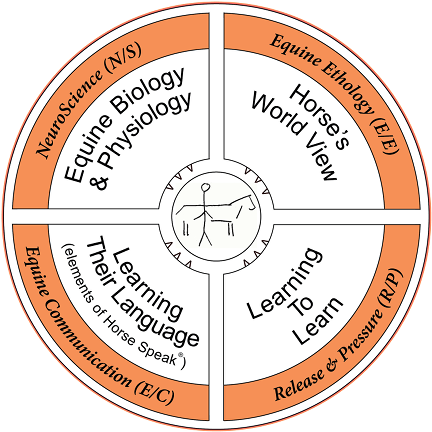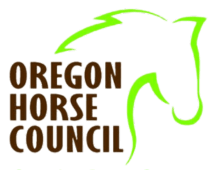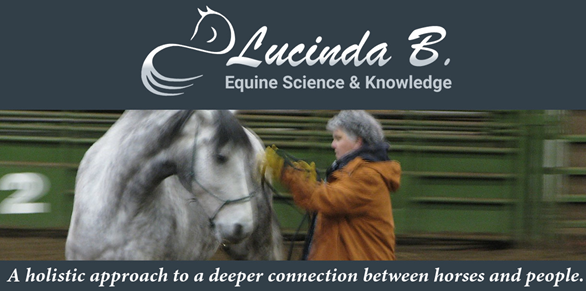Take a moment and think about what it really means to be a horse. What they see, hear, smell, taste and feel in their body.
This will be the start of your work to understand “The Horses World View”.
Horses and humans have many things in common. Both of us are warm blooded mammals that bear live young. We both have a central nervous system including the brain. Both of us have sensory receptors for taste, hearing, sight, smell, proprioception, etc.
With all those similarities- it is amazing how different we are.
The most important difference is that humans are predators and horses are prey. We have thus evolved a vastly different way of viewing, and interacting with, the world.
Understanding what is important to horses, and why, will expand our ability to work, and live in harmony, with them.

Ethology is the study of animal behavior, with Equine Ethology devoting itself to how horses behave in their natural environment- and by extension in the artificial environment of barn, paddock, arena, and trail. Through Equine Ethology, we have begun to understand the importance of their general physical, emotional, and social health. Throughout equine evolution, herds have survived and produce healthy young from these traits.
Of course, humans have been studying horses since they first met. Over the millennia, astute observers were able to figure out how to domesticate and use horses to serve humans.
“Behaviorism”- popularized in the 1930s by B.F. Skinner and Ivan Pavlov- studied animals, including horses, in laboratories under human control using human tests. They attempted to estimate the IQ or intelligence of animals by comparative testing with humans. We now know that these tests did not adequately test for the types of things animals were extremely good at and produced many misleading results.
At about the same time, the first Ethologists were doing their initial work- once again concentrating on the study of animals in their native environment. For the many who understood and lived with animals it was long overdue.

When a young Jane Goodall went to Tanzania to study chimpanzees, she was doing the work of an ethologist- despite not yet having a college degree. She was the first to live close to a chimpanzee family group and observing, firsthand, how apes behaved in the wild. Every day she sat with them and took voluminous notes. Her work, and that of others who followed her, was instrumental in making life in the zoo environment vastly better for its residents. When zoos began to understand what apes needed for their physical, emotional, and social health, enclosures evolved from plain cement enclosures resembling prison yards with little to do all day, to enclosures that better represent their natural environment.
Giving them choices of where they go and whom to interact with and giving them interesting objects to interact with has proven to keep apes healthier both mentally and physically. Zoologists learned that keeping animals without stimulation in their environment made them sick and created neurotic, stereotype behaviors.
This is equally true of all animals including the horse.

The horse’s world view is based on cultural, emotions, communication system and sexuality. Who knew! Most of the time when we are looking at our horses, we see them happily munching their hay and seemingly just hanging out with each other. Every once in a while, they get cranky for a moment and then immediately go back to eating or just milling about.
Even though it appears that horses are “just relaxing”, they actually never stop talking to each other and being aware of their environment. Human beings daydream around 80% of the time. Horses never do.
Why did horses develop the way they did?

The horse’s environment changed from the dense forest to rolling plains over thousands of years. Thus, their heads became longer and longer to enable them to eat while simultaneously watching and listening for predators over the tall grasses.

Many other changes happened that are out of the scope of this post. I address these in my clinics and webinars.

We are going to focus on the ears and eyes of the horse for now.
The horse’s eyes developed to be able to see movement on both the right and left side of their heads at the same time. Their peripheral vision is much greater than ours- about 340 degrees (nearly a complete circle) compared to about 90 degrees for a human.
Human vision is very good at focusing on one thing at a time. Horse vision traded the ability to focus on a specific object for an overall awareness of their entire environment at once.

Dragonflies are visually aware of nearly everything in a sphere around their heads because prey and predators can come at them from any direction. Horses are visually aware in wide swaths on both sides of their heads. Horse brains use this awareness from the eyes in concert with all their other extraordinary senses to be aware of and react to their environment.
When a horse becomes aware of something new- an object or sound- they

will swivel their ear(s) toward it. Where their ear goes, so does their concentration. Even though their eyesight cannot focus in a specific direction, their brain is bringing all their senses to bear to identify and classify this new “thing” as dangerous or benign.
A horse can actually do this independently on both sides of the head if necessary- essentially “focusing” in two directions at once. They can do this because if there is a threat from one direction, they must quickly “focus” in the opposite direction to plan an escape route.
When a person walks through a ranch yard, objects move out of our peripheral vision as we pass. It is necessary for us to move our head left and right to take in the whole scene. When a horse walks through the same yard, they can see everything and everybody at the same time without turning their heads.

You and the horse are processing that yard information very differently. They are aware of movement, smell, sound, and vibration that the human cannot perceive with their more limited senses. If they cannot identify the new “thing” it can set them on edge and take them out of balance and the feeling of safety. This can lead to a spook or shy or general agitation.
It is difficult for the human to keep all this in mind because their own senses are so different. Our high visual acuity and small range of vision keeps us locked in OUR world view. It takes knowledge, great imagination, and practice to remember how different they are.
I cover the practical aspects of this difference and how it affects our training in my webinars and clinics.
Both humans and horses operate from the automatic nervous system which holds the sympathetic nervous system, parasympathetic nervous system, and homeostasis.
Understanding these systems gives us the the ability to bring the emotional state of both horse and ourselves down to a place of calm/homeostasis. This brings both horse and person to a place of listening and learning. No one can hear or learn when up in the sympathetic nervous system. Understanding how they see, hear, taste, smell and move around in the world is an eye opener to a world of compassion and empathy.
When we apply good equine husbandry including understanding their world view and knowing when to address their concerns, we find a once unresponsive, concerned horse is now responsive to learning, seeking, and in over-all better general health.
For this blog I have just touched on the world view of the horse. I hope that you will join me for a clinic or webinar here at BWR on “The Horse’s World View” where we not only look at the ears and eyes but the rest of the autonomic nervous system. If you want to be kept apprised of the clinics and webinars send us your email https://www.lucindab.com/copy-of-resources or just come visit us online at
https://www.lucindab.com/events.

Have fun be safe and remember to always acknowledge your horse’s concerns.


